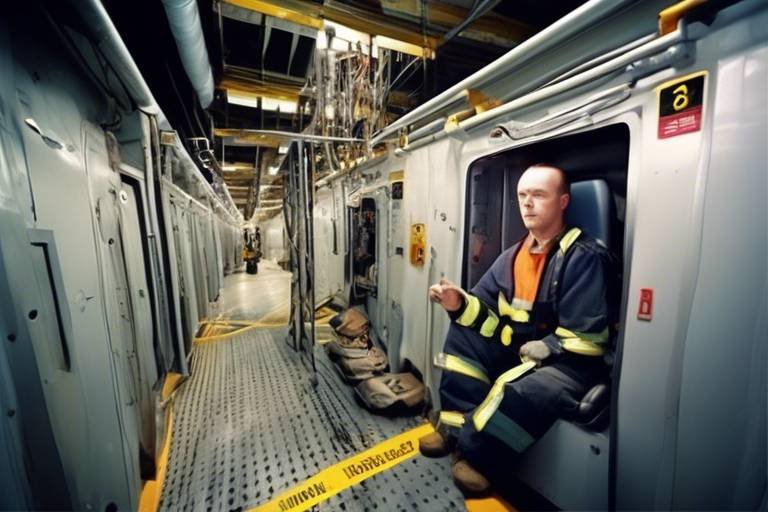Is There a Connection Between Human Behavior and Safety?
When we think about safety, we often picture hard hats, safety signs, and protective gear. However, the heart of safety lies within us—our human behavior. It's fascinating to consider how our actions, decisions, and even our psychological makeup can profoundly impact safety outcomes in various environments. Whether you're at a construction site, in a hospital, or simply crossing the street, understanding this connection can be the key to preventing accidents and enhancing well-being.
Imagine you’re driving down a busy highway. You notice a driver texting while behind the wheel. What goes through your mind? You might feel a surge of anxiety, knowing that this individual’s behavior could lead to a catastrophic accident. This scenario illustrates a fundamental truth: our behavior directly affects not only our own safety but also the safety of those around us. It raises an important question: How can we improve our safety practices by understanding human behavior?
To answer this, we need to dive deep into the psychology of risk perception. It's essential to grasp how we assess danger and the cognitive biases that can cloud our judgment. For example, have you ever heard the term "optimism bias"? This is when we believe that bad things are less likely to happen to us than to others. Such biases can lead to complacency in safety practices, making us underestimate risks that are very real. It’s as if we’re walking a tightrope, convinced we won’t fall, even though the ground is just a misstep away.
Furthermore, our environments play a significant role in shaping our behaviors. Consider a workplace with a strong safety culture versus one that neglects safety protocols. In the former, employees are more likely to adhere to safety measures because they feel supported and valued. In contrast, in a workplace where safety is an afterthought, individuals may take unnecessary risks, believing that the chance of an accident is low. This highlights the importance of fostering a culture that prioritizes safety—because when people feel safe, they act safely.
In conclusion, the connection between human behavior and safety is not just a topic for academic discussion; it’s a vital aspect of our daily lives. Understanding the psychological factors that influence our decisions can lead to improved safety practices across all environments. So, the next time you think about safety, remember that it starts with you and your choices. By changing our behaviors and fostering a culture of safety, we can significantly reduce risks and create a safer world for everyone.

The Psychology of Risk Perception
Understanding how individuals perceive risk is crucial to improving safety measures. Our perception of risk isn’t just a straightforward calculation of probabilities; it’s a complex interplay of cognitive biases, emotional responses, and past experiences. Imagine walking down a dark alley at night. Your heart races not just because of the potential dangers but also due to the stories you’ve heard about similar situations. This is the essence of risk perception—our brains are wired to assess danger based on a myriad of factors that go beyond mere statistics.
One of the key elements influencing risk perception is the existence of cognitive biases. These biases can skew our understanding and lead us to either overestimate or underestimate risks in various situations. For instance, if someone has recently heard about a plane crash, they may develop an irrational fear of flying, despite the fact that statistically, air travel is one of the safest modes of transportation. This phenomenon can be partially attributed to the availability heuristic, where individuals judge the likelihood of events based on how easily examples come to mind. In this case, the vividness of the news story overshadows the overwhelming evidence supporting the safety of flying.
Another factor at play is our emotional response to risk. Emotions can cloud judgment and lead to inconsistent decision-making. For example, fear can paralyze us, making it difficult to act even when we know the right course of action. Conversely, overconfidence can lead individuals to take unnecessary risks, believing that they are invulnerable. This is particularly concerning in high-stakes environments like construction sites or healthcare settings, where the consequences of poor decision-making can be severe.
To illustrate these concepts further, consider the following table which summarizes common cognitive biases affecting risk perception:
| Cognitive Bias | Description | Impact on Risk Perception |
|---|---|---|
| Overconfidence Bias | Believing one is less likely to experience a negative event than others. | Underestimation of risks, leading to reckless behavior. |
| Availability Heuristic | Judging the probability of events based on recent experiences. | Overestimation of risks associated with recent or vivid events. |
| Anchoring Bias | Relying too heavily on the first piece of information encountered. | Inability to adjust risk assessments based on new data. |
As we navigate through life, it’s essential to recognize these biases and emotional factors shaping our risk perceptions. By doing so, we can take proactive steps to enhance our safety practices. For instance, implementing structured decision-making processes and promoting evidence-based training can help counteract the effects of cognitive biases. It’s not just about knowing the risks; it’s about understanding how we perceive and respond to them.
In conclusion, the psychology of risk perception is a multifaceted area that significantly impacts safety outcomes. By acknowledging the cognitive and emotional factors that influence our decisions, we can work towards creating a safer environment, one where individuals are equipped to make informed choices rather than relying on flawed perceptions.

When we talk about safety management, it's easy to focus on the technical aspects—like equipment, protocols, and regulations. However, human factors play a pivotal role in shaping how safety is perceived and implemented in various environments. Understanding these factors is essential for creating a robust safety culture that minimizes risks and enhances overall performance. Human behavior, after all, can either be the strongest link in the safety chain or its weakest point.
To navigate the complexities of safety management effectively, we need to consider a range of elements that influence human behavior. These include ergonomics, which pertains to designing tasks and environments that fit human abilities and limitations, and behavioral psychology, which examines how people make decisions in the face of risks. For instance, a well-designed workspace can reduce the likelihood of accidents by minimizing physical strain and distractions, thereby allowing individuals to focus better on their tasks.
Moreover, environmental influences—like lighting, noise levels, and even organizational structures—can significantly impact how individuals perceive and react to safety protocols. A chaotic work environment may lead to increased stress, which can, in turn, result in hasty decisions that compromise safety. Therefore, it's vital to create an atmosphere that promotes calmness and focus while encouraging mindful behavior.
In safety management, it's also crucial to recognize that people are not just cogs in a machine. They bring their own experiences, emotions, and cognitive biases to the table. Understanding these human elements allows safety managers to tailor their approaches effectively. For example, when introducing new safety procedures, it’s essential to consider how these changes might be received by employees. A well-thought-out implementation strategy that includes employee feedback can lead to greater acceptance and compliance.
To illustrate the impact of human factors on safety management, let’s consider a few key areas:
| Human Factor | Impact on Safety |
|---|---|
| Ergonomics | Reduces physical strain, enhancing focus and reducing errors. |
| Emotional State | Stress can lead to hasty decisions, increasing accident risks. |
| Training | Informed employees are more likely to adhere to safety protocols. |
| Communication | Open dialogue fosters a culture of safety, encouraging reporting of hazards. |
Ultimately, all these factors converge to shape an organization’s safety performance. By recognizing and addressing human factors, we can create a safer workplace that not only meets compliance standards but also fosters a culture where safety is a shared responsibility. In this context, safety management is not merely about enforcing rules; it’s about understanding and influencing human behavior to cultivate a proactive safety mindset.
In summary, the intricate interplay between human behavior and safety management cannot be overstated. By focusing on ergonomics, emotional states, training, and communication, organizations can significantly enhance their safety performance and create an environment where every individual feels empowered to contribute to safety initiatives.
- What are human factors in safety management?
The human factors in safety management refer to the psychological, social, and physical aspects that influence how individuals behave in relation to safety protocols and practices. - How do cognitive biases affect safety decisions?
Cognitive biases can lead individuals to misjudge risks, often resulting in unsafe behaviors or decisions. Recognizing these biases is essential for effective safety training. - Why is training important for safety?
Effective training equips employees with the knowledge and skills necessary to recognize and respond appropriately to safety hazards, thereby reducing the likelihood of accidents. - What role does organizational culture play in safety?
A strong safety culture encourages employees to prioritize safety, communicate openly about risks, and adhere to safety protocols, leading to fewer accidents and injuries.

Cognitive biases are like the sneaky little gremlins in our minds, subtly influencing how we perceive risks and make decisions, especially in safety contexts. When it comes to making choices that affect our safety, these biases can lead us down a slippery slope of poor judgment. Imagine you’re driving down a highway and you see a sign warning of slippery roads. Instead of slowing down, you might think, “I’ve driven in worse conditions before; I’ll be fine.” This is a classic example of how overconfidence can cloud our judgment, making us underestimate the actual risks involved.
One of the most prevalent cognitive biases is the overconfidence bias, where individuals overestimate their own abilities or knowledge. This can be particularly dangerous in environments where safety is paramount. For instance, a worker might believe they can handle hazardous materials without proper protective equipment, thinking, “I’ve done it before without any issues.” This overconfidence can lead to reckless behavior and, ultimately, accidents. To combat this, it’s essential to foster a culture of humility and continuous learning, reminding individuals that safety is not just about skill but also about awareness and caution.
Another significant cognitive bias is the availability heuristic, which causes people to evaluate the likelihood of an event based on how easily examples come to mind. For example, if someone recently heard about a workplace accident involving a machine, they might start to perceive that machine as more dangerous than it statistically is. This can skew their risk assessment and lead to unnecessary fear or, conversely, complacency if they haven’t experienced or heard of an accident in a long time. Understanding this bias can help organizations implement safety measures that address both perceived and actual risks more effectively.
To illustrate these biases further, consider the following table that outlines common cognitive biases and their potential impacts on decision-making in safety contexts:
| Cognitive Bias | Description | Impact on Safety |
|---|---|---|
| Overconfidence Bias | Overestimating one's abilities or knowledge | Leads to risky behavior and accidents |
| Availability Heuristic | Judging the likelihood of events based on recent examples | Can result in skewed risk perceptions |
| Confirmation Bias | Focusing on information that confirms existing beliefs | Ignores contrary evidence, leading to unsafe practices |
| Anchoring Bias | Relying too heavily on the first piece of information encountered | Can hinder the assessment of new safety information |
Recognizing these cognitive biases is just the first step. Organizations can take proactive measures to mitigate their effects. This includes fostering an environment where safety is prioritized, encouraging open discussions about risks, and implementing regular training to reinforce safe practices. By understanding how these biases affect decision-making, both individuals and organizations can make more informed choices that ultimately enhance safety outcomes.

Overconfidence bias is a fascinating psychological phenomenon that can significantly impact our safety practices. Imagine you're driving a car, and you feel invincible, thinking, "I’ve driven for years; nothing bad will happen to me." This mindset can lead to risky behaviors, such as speeding or ignoring traffic signals, because you underestimate the actual dangers on the road. Overconfidence can create a false sense of security, making individuals more prone to taking unnecessary risks.
This bias is not limited to driving; it can surface in various settings, from workplaces to home environments. For instance, in a manufacturing context, a worker might believe they can operate heavy machinery without proper training. This overestimation of their capabilities can lead to accidents, injuries, or even fatalities. The implications of overconfidence bias are profound, as it can result in a disregard for safety protocols and an increase in hazardous behaviors.
To mitigate the effects of overconfidence bias, organizations can implement several strategies:
- Regular Training: Continuous education and training can help remind individuals of the risks associated with their tasks, reinforcing the importance of following safety protocols.
- Encouraging Self-Awareness: Encouraging individuals to assess their skills realistically can help combat overconfidence. This can involve self-reflection exercises or peer feedback sessions.
- Safety Audits: Conducting regular safety audits can highlight areas where overconfidence may lead to unsafe practices, helping to address these issues proactively.
Ultimately, recognizing and addressing overconfidence bias is crucial for fostering a culture of safety. When individuals are aware of their limitations and the potential risks they face, they are more likely to engage in safe practices and adhere to safety guidelines. Leaders within organizations can play a pivotal role in this by promoting a culture of humility and continuous learning, where safety is prioritized over bravado. By doing so, they can help create an environment where everyone feels responsible for their safety and the safety of those around them.
In conclusion, overconfidence bias is a double-edged sword. While confidence can empower individuals to take on challenges, unchecked overconfidence can lead to dangerous situations. By fostering awareness and implementing effective training programs, we can harness the positive aspects of confidence while mitigating the risks associated with overconfidence bias.
Q1: What is overconfidence bias?
Overconfidence bias is a cognitive bias where individuals overestimate their abilities or knowledge, leading to risky behaviors and poor decision-making, particularly in safety contexts.
Q2: How can organizations reduce overconfidence bias?
Organizations can reduce overconfidence bias by providing regular training, encouraging self-awareness, and conducting safety audits to highlight potential risks.
Q3: Why is recognizing overconfidence bias important?
Recognizing overconfidence bias is crucial because it helps individuals understand their limitations and the risks they face, promoting safer behaviors and adherence to safety protocols.

The availability heuristic is a fascinating cognitive shortcut that our brains use to make quick judgments about the likelihood of events based on how easily examples come to mind. You know that feeling when you hear about a plane crash on the news, and suddenly you're convinced that flying is incredibly dangerous? That’s the availability heuristic at work! It leads us to overestimate risks that are more memorable or recent, while downplaying those that are less sensational or further back in our memory.
In safety contexts, this can have serious implications. For instance, if a worker has recently witnessed a near-miss incident at a construction site, they might become overly cautious about similar situations, even if statistically, the risk of such incidents is low. This can lead to an environment of heightened anxiety, where individuals are constantly on edge, potentially causing them to overlook other, more pressing safety issues. In contrast, if someone hasn’t experienced an accident in a long time, they might falsely believe that safety measures are unnecessary, leading to complacency.
To illustrate this point, consider the following table that highlights how the availability heuristic affects various safety perceptions:
| Recent Event | Perceived Risk Level | Actual Risk Level |
|---|---|---|
| Plane crash in the news | High | Low |
| Workplace injury report | Very High | Moderate |
| Car accidents in winter | High | High |
As you can see, the perceived risk often does not align with the actual risk level. This discrepancy can lead to misjudgments in safety practices, where individuals may overreact to certain dangers while neglecting others that might be more hazardous. It’s like driving a car while obsessively checking the backseat for ghosts, ignoring the fact that the road ahead is full of potholes!
To combat the effects of the availability heuristic, organizations can implement strategies such as regular safety training that includes a wide range of potential hazards, not just those that have recently occurred. This helps to broaden the perspective of employees, allowing them to recognize that safety is a continuous concern rather than something that fluctuates with the latest news headlines. By fostering a more comprehensive understanding of risks, we can create a safer work environment where decisions are made based on facts rather than fleeting memories.
- What is the availability heuristic?
The availability heuristic is a mental shortcut that relies on immediate examples that come to a person's mind when evaluating a specific topic, concept, method, or decision.
- How does the availability heuristic affect safety?
It can lead individuals to overestimate risks based on recent experiences or news, potentially causing them to react inappropriately to actual dangers.
- What can organizations do to mitigate the effects of the availability heuristic?
Organizations can provide comprehensive safety training that covers a wide range of potential hazards, helping employees to make informed decisions based on a broader understanding of risks.

When it comes to safety, the importance of training and education cannot be overstated. Imagine stepping into a workplace where every individual is not only aware of the potential hazards but is also equipped with the skills to handle them. This is the power of effective training. It’s not just about knowing the rules; it’s about understanding the why behind those rules and how they apply to real-life situations.
Training programs designed with a focus on safety can significantly enhance an individual's ability to recognize risks and respond appropriately. For instance, consider a fire drill. It’s not just a routine exercise; it’s a critical training opportunity that prepares employees for the unexpected. When participants engage in realistic scenarios, they build confidence and competence, which are essential for quick decision-making during emergencies.
Moreover, education plays a pivotal role in fostering a culture of safety. By incorporating safety training into the onboarding process, organizations can instill a sense of responsibility from the very beginning. This proactive approach not only equips new employees with essential knowledge but also emphasizes the organization's commitment to safety. When safety becomes part of the organizational culture, it encourages everyone to look out for one another, creating a supportive environment where safety is prioritized.
To illustrate the impact of training, let’s take a look at a few key methods that can enhance safety awareness:
- Hands-on Training: Practical, hands-on training sessions allow employees to practice skills in a controlled environment, making them more prepared for real-life situations.
- Simulation Exercises: Using simulations can replicate hazardous situations without the actual risk, helping employees to develop critical thinking and problem-solving skills under pressure.
- Regular Refresher Courses: Safety protocols can evolve, so regular training updates ensure that all employees are aware of the latest practices and technologies.
In addition to these methods, leveraging technology can also enhance training outcomes. For instance, virtual reality (VR) and augmented reality (AR) can create immersive training experiences that engage participants more effectively than traditional methods. These technologies allow employees to navigate complex scenarios in a safe environment, leading to better retention of safety practices.
Furthermore, the role of leadership in promoting training and education cannot be overlooked. Leaders who actively participate in training sessions demonstrate their commitment to safety, inspiring their teams to take the training seriously. When leaders lead by example, it fosters a culture where safety becomes a shared value among all employees.
In conclusion, the role of training and education in safety cannot be underestimated. They are not merely compliance tasks but essential components of a successful safety strategy. By investing in comprehensive training programs, organizations can empower their employees to make informed decisions, ultimately leading to a safer working environment for everyone.
- Why is training important for safety?
Training equips employees with the necessary skills and knowledge to identify and respond to hazards effectively. - How often should safety training be conducted?
Regular training sessions should be conducted, ideally at least annually, with refresher courses as needed. - What are the benefits of using technology in training?
Technology, such as VR and AR, enhances engagement and retention, allowing for realistic practice in a safe environment.

When we talk about safety in any environment, whether it’s a workplace, school, or even at home, we can’t ignore the profound impact of organizational culture. Culture is like the invisible glue that holds a group together, shaping behaviors, attitudes, and ultimately, safety outcomes. Imagine a team working in a factory where safety is just a checkbox on a list; now picture another team where safety is a core value. The difference in behavior and accident rates can be staggering!
Research shows that a strong safety culture can significantly reduce accidents and injuries. But what does that mean in practical terms? A positive safety culture promotes open communication, where employees feel safe to report hazards without fear of retribution. This kind of environment encourages individuals to speak up about unsafe practices, share their experiences, and learn from one another. So, how do we cultivate such a culture?
First, it’s essential to establish clear safety policies that everyone understands and agrees upon. These policies should not only be written down but also actively discussed in meetings and training sessions. Think of safety policies as the foundation of a house; without a solid foundation, everything else is at risk of collapsing. Additionally, involving employees in the creation of these policies can foster a sense of ownership and responsibility.
Another critical aspect is the role of leadership. Leaders must lead by example, demonstrating safe practices in their daily routines. When leaders prioritize safety, it sends a powerful message to the entire organization. It’s like a captain steering a ship; if the captain is careless, the crew will follow suit. Conversely, a captain who emphasizes safety will inspire the crew to do the same.
Furthermore, organizations can implement regular safety training sessions that engage employees at all levels. These sessions should be interactive and tailored to the specific risks associated with the workplace. By making training relevant and engaging, employees are more likely to retain the information and apply it in real-life situations. Consider this: a well-informed employee is like a well-equipped soldier; they are ready to face challenges head-on!
In addition to training, fostering a culture of recognition can also enhance safety behavior. Recognizing and rewarding safe practices reinforces the idea that safety is valued within the organization. This can be as simple as a shout-out in a meeting or a more formal recognition program. When employees see that their safe behaviors are acknowledged, they are more likely to continue those behaviors.
Finally, it’s crucial to regularly assess and improve the safety culture within an organization. This can be done through employee surveys, safety audits, and open forums for discussion. By continuously seeking feedback and making necessary adjustments, organizations can ensure that their safety culture evolves and remains effective.
In summary, the connection between culture and safety behavior is undeniable. By fostering a strong safety culture through clear policies, engaged leadership, effective training, and recognition, organizations can significantly improve their safety outcomes. Remember, safety isn’t just a set of rules; it’s a way of life that requires constant attention and commitment.
- What is safety culture? Safety culture refers to the shared values, beliefs, and behaviors that prioritize safety within an organization.
- How can leadership influence safety culture? Leaders can influence safety culture by modeling safe behaviors, communicating openly about safety, and prioritizing safety in decision-making.
- Why is employee involvement important in safety practices? Involving employees in safety practices fosters a sense of ownership and responsibility, leading to a more proactive approach to safety.
- What role does training play in improving safety culture? Training equips employees with the knowledge and skills necessary to recognize and mitigate risks, reinforcing a culture of safety.

When it comes to safety in any environment, the importance of communication and team dynamics cannot be overstated. Imagine a well-oiled machine, where every cog and gear works in perfect harmony. That's what effective communication achieves within a team. It fosters an environment where individuals feel empowered to voice their concerns, share insights, and collaborate on safety practices. But what does this really look like in practice?
First off, let’s consider the role of open communication. This means creating a culture where team members feel safe to express their thoughts without fear of judgment or retribution. For instance, if a worker notices a potential hazard, they should feel encouraged to report it immediately. When communication flows freely, it not only helps in identifying risks but also in formulating strategies to mitigate them. In fact, studies have shown that teams with strong communication practices experience significantly fewer accidents.
Next, let’s talk about team dynamics. The way a team interacts can greatly influence safety outcomes. A cohesive team that understands each other’s strengths and weaknesses is more likely to operate safely. For example, if a team member is particularly skilled at identifying hazards, others can rely on them to lead discussions on safety measures. This kind of synergy is crucial, especially in high-risk environments like construction sites or manufacturing plants.
Moreover, effective communication enhances team cohesion. When team members communicate openly, they build trust and camaraderie. Trust is essential in a safety context because it encourages individuals to look out for one another. A team that communicates well is more likely to engage in proactive safety behaviors, such as conducting regular safety drills or sharing best practices. In contrast, a lack of communication can lead to misunderstandings, which can be detrimental to safety.
To illustrate the impact of communication on team dynamics, consider the following table:
| Aspect | Impact of Effective Communication | Impact of Poor Communication |
|---|---|---|
| Risk Identification | Quick and accurate reporting of hazards | Delayed or missed hazard reports |
| Team Trust | High levels of trust and collaboration | Low morale and increased conflict |
| Safety Training | Informed and engaged team members | Disengaged and unprepared employees |
In addition to fostering communication, it’s essential to focus on team dynamics through regular team-building activities. These activities can range from simple icebreakers to more complex problem-solving exercises that require collaboration. Such initiatives not only enhance interpersonal relationships but also reinforce the importance of safety as a shared responsibility. When team members bond over shared experiences, they are more likely to support each other in maintaining a safe work environment.
Finally, let’s not overlook the role of leadership in promoting effective communication and positive team dynamics. Leaders set the tone for how communication is handled within the team. By modeling open communication and actively seeking input from all team members, leaders can cultivate a culture of safety that resonates throughout the organization. After all, a leader who prioritizes safety and encourages dialogue is more likely to inspire their team to do the same.
- How can I improve communication within my team?
Encourage open dialogue, hold regular meetings, and create an environment where feedback is welcomed. - What are some effective team-building activities for enhancing safety?
Consider safety drills, workshops, or even casual team outings that promote bonding. - Why is trust important for safety?
Trust fosters collaboration and encourages team members to look out for one another.

When it comes to fostering a safe working environment, the phrase "actions speak louder than words" couldn't be more relevant. Leaders who prioritize safety and demonstrate it through their own behaviors set a powerful precedent for their teams. It's not just about implementing safety protocols; it's about embodying them. When leaders consistently practice safe behaviors, they create a culture where safety is valued and prioritized. This can significantly reduce incidents and accidents in the workplace.
Consider this: if a manager frequently wears personal protective equipment (PPE) and adheres to safety guidelines, employees are more likely to follow suit. This is because they see their leaders as role models. In contrast, if a leader disregards safety protocols, it sends a message that safety is not a priority, which can lead to a dangerous environment. The ripple effect of leadership behavior can be profound.
Moreover, leading by example can also involve open discussions about safety practices. Leaders should not only enforce rules but also engage their teams in conversations about safety. This can include sharing near-miss incidents or discussing improvements in safety protocols. When employees see their leaders actively participating in safety discussions, it reinforces the message that safety is a shared responsibility.
To further illustrate the impact of leadership on safety behavior, let's look at a hypothetical scenario. Imagine a construction site where the foreman consistently checks that all workers are wearing their hard hats and safety vests. He doesn’t just do this once; he makes it a part of his daily routine. Over time, the crew begins to adopt this behavior, and soon, wearing PPE becomes second nature. In contrast, if the foreman were to skip these checks, the workers might begin to feel that safety is optional, leading to a higher risk of accidents.
In addition to demonstrating safe practices, leaders should also recognize and reward safe behavior among their team members. This could be as simple as acknowledging a team member who reports a hazard or suggesting a safety improvement. By celebrating these actions, leaders reinforce the idea that safety is a core value of the organization. It creates an environment where employees feel empowered to take initiative regarding their own safety and that of their colleagues.
Ultimately, leading by example is about creating a culture of safety that permeates every level of an organization. It requires commitment, consistency, and the willingness to engage with employees about safety matters. When leaders take safety seriously, it encourages everyone else to do the same. The result is a safer workplace where employees feel valued and protected.
- Why is leading by example important for safety?
Leading by example is crucial because it sets the tone for the entire organization. When leaders prioritize safety, employees are more likely to follow suit, creating a culture of safety. - How can leaders effectively communicate about safety?
Leaders can communicate about safety by holding regular safety meetings, encouraging open dialogue, and sharing personal experiences regarding safety practices. - What are some ways to recognize safe behavior in the workplace?
Leaders can recognize safe behavior through verbal praise, safety awards, or by highlighting safe practices in company newsletters or meetings.
Frequently Asked Questions
- What is the connection between human behavior and safety?
Human behavior is intricately linked to safety outcomes. Our actions, decisions, and psychological factors can significantly influence how safe we feel and how we respond to potential hazards. Understanding this connection helps in developing better safety measures.
- How does risk perception affect safety?
Risk perception is the way individuals assess danger, which can be influenced by cognitive biases and emotions. If someone overestimates or underestimates a risk, it can lead to unsafe behaviors. Improving our understanding of these perceptions is crucial for enhancing safety protocols.
- What are cognitive biases, and how do they impact safety decisions?
Cognitive biases are systematic patterns of deviation from norm or rationality in judgment. They can lead to poor decision-making in safety contexts, such as underestimating risks or overreacting to certain threats, thus affecting overall safety performance.
- What is the overconfidence bias?
The overconfidence bias is when individuals believe they are less likely to experience negative outcomes than others. This can lead to risky behaviors and poor safety practices, making it essential to recognize and mitigate its effects in safety training.
- How does the availability heuristic influence safety perception?
The availability heuristic causes individuals to assess risks based on recent experiences or easily recalled events. This can lead to misjudgments about safety threats, as people may overlook less obvious but more significant dangers.
- Why is training important for safety?
Effective training and education are vital for promoting safe behaviors. They enhance awareness and skills, ensuring that individuals know how to react appropriately in hazardous situations, ultimately leading to a safer environment.
- How does organizational culture impact safety behavior?
A strong safety culture fosters positive behaviors and reduces accidents. When organizations prioritize safety and promote a culture of accountability and communication, employees are more likely to engage in safe practices.
- What role does communication play in safety?
Open communication is essential for safety. It ensures that team members can share concerns, report hazards, and collaborate effectively, leading to improved safety outcomes in group settings.
- How can leaders influence safety behaviors?
Leaders play a crucial role in shaping safety behaviors by modeling safe practices themselves. When leaders demonstrate commitment to safety, it sets a standard for their teams and encourages a culture of safety throughout the organization.


















